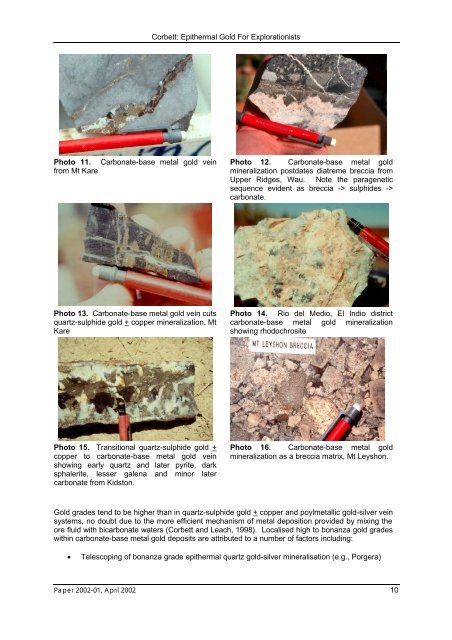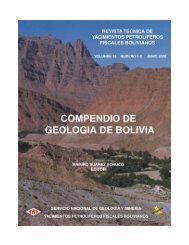Exploraciones por oro epitermal
You also want an ePaper? Increase the reach of your titles
YUMPU automatically turns print PDFs into web optimized ePapers that Google loves.
Corbett: Epithermal Gold For Explorationists<br />
Photo 11. Carbonate-base metal gold vein<br />
from Mt Kare<br />
Photo 12. Carbonate-base metal gold<br />
mineralization postdates diatreme breccia from<br />
Upper Ridges, Wau. Note the paragenetic<br />
sequence evident as breccia -> sulphides -><br />
carbonate.<br />
Photo 13. Carbonate-base metal gold vein cuts<br />
quartz-sulphide gold + copper mineralization, Mt<br />
Kare<br />
Photo 14. Rio del Medio, El Indio district<br />
carbonate-base metal gold mineralization<br />
showing rhodochrosite<br />
Photo 15. Transitional quartz-sulphide gold +<br />
copper to carbonate-base metal gold vein<br />
showing early quartz and later pyrite, dark<br />
sphalerite, lesser galena and minor later<br />
carbonate from Kidston.<br />
Photo 16. Carbonate-base metal gold<br />
mineralization as a breccia matrix, Mt Leyshon.<br />
Gold grades tend to be higher than in quartz-sulphide gold + copper and poylmetallic gold-silver vein<br />
systems, no doubt due to the more efficient mechanism of metal deposition provided by mixing the<br />
ore fluid with bicarbonate waters (Corbett and Leach, 1998). Localised high to bonanza gold grades<br />
within carbonate-base metal gold deposits are attributed to a number of factors including:<br />
• Telescoping of bonanza grade epithermal quartz gold-silver mineralisation (e.g., Porgera)<br />
Paper 2002-01, April 2002 10
















